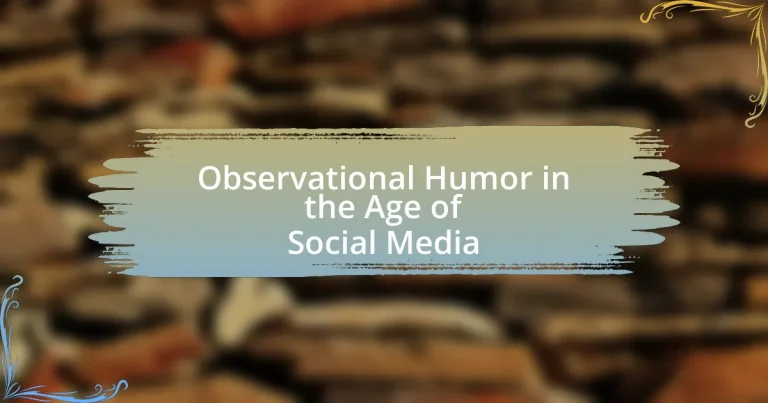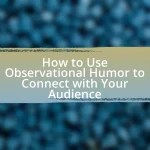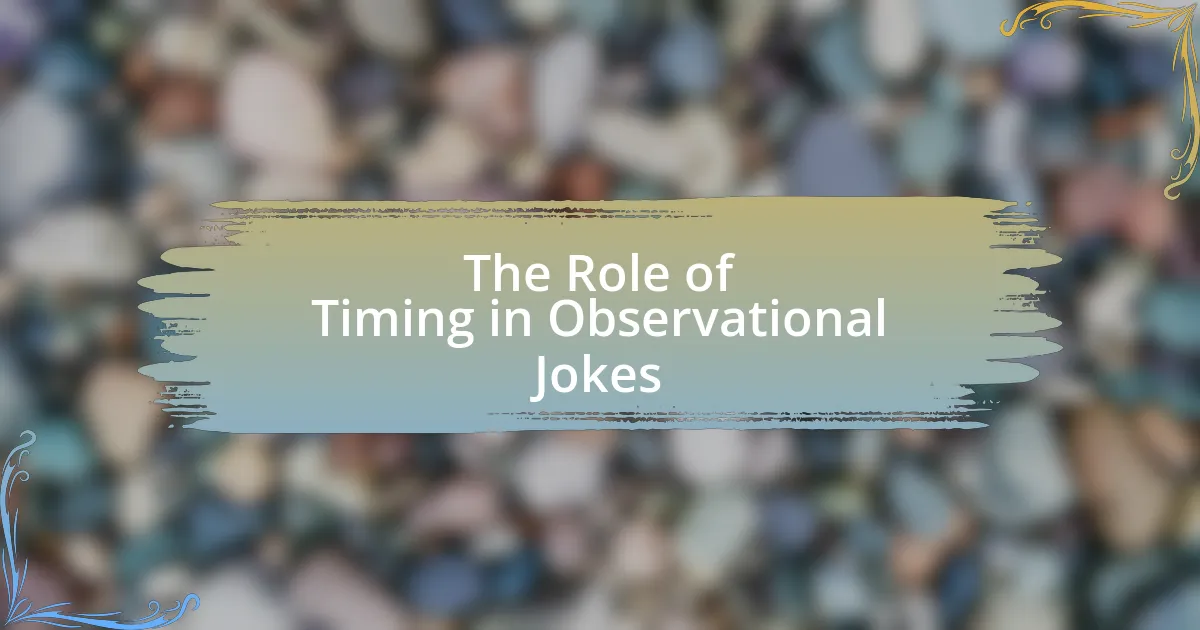Observational humor in the age of social media is a comedic style that emphasizes everyday experiences and societal norms, primarily shared through platforms like Twitter, Instagram, and TikTok. This article explores how social media has transformed the landscape of observational humor by enabling rapid dissemination and interaction, allowing diverse voices to contribute to the genre. Key characteristics such as relatability, simplicity, and immediacy are discussed, along with the influence of audience engagement on the effectiveness of humor. Additionally, the article examines the role of influencers in shaping observational humor and the impact of current events on its relevance, providing insights into best practices for creating effective comedic content in today’s digital culture.
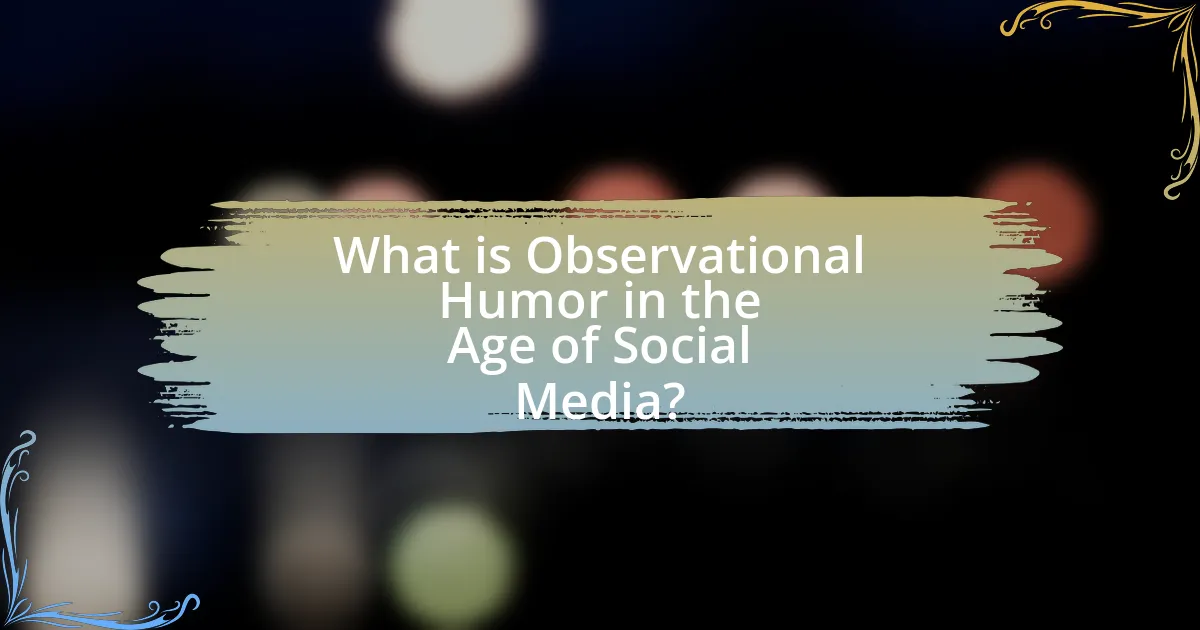
What is Observational Humor in the Age of Social Media?
Observational humor in the age of social media refers to the comedic style that highlights everyday experiences and societal norms, often shared through platforms like Twitter, Instagram, and TikTok. This form of humor thrives on the immediacy and accessibility of social media, allowing comedians and users to quickly comment on relatable situations, cultural trends, and personal anecdotes. The rapid dissemination of content enables observational humor to reach a wide audience, with viral posts often reflecting shared sentiments or experiences, thus reinforcing community and connection among users. For instance, studies show that humor related to common life experiences garners higher engagement rates on social media, illustrating its effectiveness in resonating with audiences.
How has social media transformed the landscape of observational humor?
Social media has transformed the landscape of observational humor by enabling rapid dissemination and interaction with comedic content. Platforms like Twitter, Instagram, and TikTok allow users to share humorous observations instantly, reaching a global audience and fostering real-time engagement. This shift has democratized humor, allowing diverse voices to contribute and gain recognition, as evidenced by the rise of viral memes and short comedic videos that often reflect current societal trends and issues. The immediacy of social media also encourages comedians to adapt their material quickly, responding to cultural moments and audience feedback, which enhances the relevance and relatability of their humor.
What are the key characteristics of observational humor in this context?
The key characteristics of observational humor in the context of social media include relatability, simplicity, and immediacy. Relatability allows audiences to connect with everyday experiences, making the humor more impactful. Simplicity ensures that the humor is easily digestible and can be quickly understood, which is crucial in the fast-paced social media environment. Immediacy refers to the ability to comment on current events or trends, allowing humor to remain relevant and timely. These characteristics are evident in viral memes and posts that resonate with a wide audience, often reflecting shared experiences or societal norms.
How does social media influence the delivery of observational humor?
Social media significantly influences the delivery of observational humor by providing a platform for rapid dissemination and audience interaction. This immediacy allows comedians and content creators to share relatable observations in real-time, adapting their humor to current events and trends. For instance, platforms like Twitter and Instagram enable users to post short, witty remarks that resonate with a wide audience, often leading to viral content. Research indicates that humor shared on social media can enhance engagement, with studies showing that posts containing humor receive 50% more shares than those without. This dynamic interaction fosters a feedback loop where comedians refine their material based on audience reactions, further shaping the style and delivery of observational humor.
Why is observational humor significant in today’s digital culture?
Observational humor is significant in today’s digital culture because it resonates with the shared experiences of individuals, fostering connection and relatability. This type of humor thrives on the internet, where social media platforms allow for rapid dissemination and engagement, making it a powerful tool for communication. According to a study by the Pew Research Center, 69% of adults in the U.S. use social media, creating a vast audience for content that reflects everyday life. This widespread accessibility enhances the impact of observational humor, as it often highlights common situations that many can identify with, thus promoting social bonding and community.
What role does observational humor play in social interactions online?
Observational humor serves as a vital tool for enhancing social interactions online by fostering relatability and connection among users. This type of humor allows individuals to share common experiences and perspectives, creating a sense of community and understanding. Research indicates that humor can increase engagement on social media platforms, as posts containing observational humor often receive higher levels of likes, shares, and comments, thereby facilitating interaction. For instance, a study published in the Journal of Computer-Mediated Communication found that humorous content significantly boosts user engagement, demonstrating the effectiveness of observational humor in capturing attention and encouraging dialogue.
How does it reflect societal norms and behaviors?
Observational humor in the age of social media reflects societal norms and behaviors by highlighting shared experiences and cultural references that resonate with a broad audience. This type of humor often addresses everyday situations, social interactions, and common frustrations, thereby reinforcing collective values and expectations. For instance, comedians and content creators frequently use platforms like Twitter and Instagram to comment on social dynamics, such as the impact of technology on relationships or the absurdities of modern life, which mirrors the audience’s lived experiences. Research indicates that humor serves as a social bonding mechanism, facilitating connections among individuals who relate to similar societal contexts, thus validating the role of observational humor in shaping and reflecting contemporary social norms.
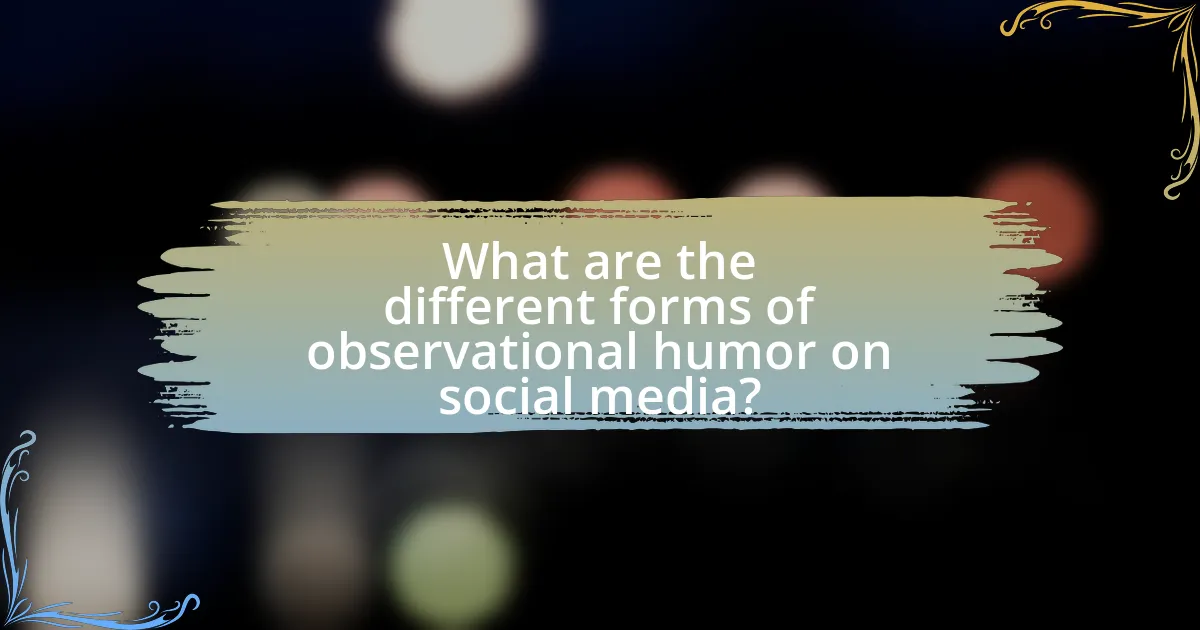
What are the different forms of observational humor on social media?
Different forms of observational humor on social media include memes, tweets, video skits, and status updates. Memes often utilize relatable images or phrases to highlight everyday situations, making them easily shareable and recognizable. Tweets frequently capture humorous observations about current events or personal experiences in a concise format, allowing for quick engagement. Video skits, often shared on platforms like TikTok or Instagram, present comedic takes on relatable scenarios through performance. Status updates on platforms like Facebook can also convey observational humor through witty commentary on daily life. These forms leverage the interactive nature of social media, enabling users to connect over shared experiences and perspectives.
How do memes contribute to observational humor?
Memes contribute to observational humor by encapsulating relatable experiences and social commentary in a concise and visually engaging format. This form of humor often highlights everyday situations, allowing individuals to connect through shared experiences, which enhances the comedic effect. For instance, a meme depicting a common struggle, such as procrastination, resonates with a wide audience, making the humor more impactful. Research indicates that memes can spread rapidly across social media platforms, amplifying their reach and reinforcing communal laughter around shared observations, thus solidifying their role in contemporary humor.
What are the most popular meme formats used for observational humor?
The most popular meme formats used for observational humor include the “Distracted Boyfriend,” “Two Buttons,” and “Expanding Brain.” These formats effectively convey relatable situations and emotions, making them ideal for observational humor. For instance, the “Distracted Boyfriend” meme illustrates the conflict between current desires and responsibilities, while the “Two Buttons” format highlights the difficulty of making choices in everyday life. The “Expanding Brain” meme humorously depicts the progression of thought, often contrasting simple ideas with more complex ones. These formats have gained widespread recognition and usage on platforms like Instagram and Twitter, demonstrating their effectiveness in engaging audiences with relatable content.
How do memes enhance relatability in observational humor?
Memes enhance relatability in observational humor by distilling complex social experiences into simple, recognizable images and captions that resonate with a wide audience. This visual shorthand allows individuals to quickly identify with shared feelings or situations, making humor more accessible and engaging. Research indicates that memes often reflect common cultural references and everyday scenarios, which fosters a sense of community among viewers. For instance, a study by Shifman (2014) highlights how memes serve as a form of social commentary, allowing people to connect over shared frustrations or joys, thereby amplifying the humor’s impact through collective recognition.
What role do influencers play in shaping observational humor?
Influencers play a significant role in shaping observational humor by leveraging their platforms to highlight everyday experiences and societal norms in a relatable manner. They create content that resonates with their audience, often using humor to comment on shared experiences, thus making observational humor more accessible and widespread. For instance, influencers like Kevin Hart and Ellen DeGeneres utilize their social media presence to share humorous takes on daily life, which not only entertains but also encourages audience engagement through shared laughter. This dynamic amplifies the reach of observational humor, as influencers can quickly disseminate their comedic insights to millions, shaping cultural perceptions and trends in humor.
How do influencers use observational humor to engage their audience?
Influencers use observational humor to engage their audience by highlighting relatable everyday experiences that resonate with their followers. This technique fosters a sense of connection and community, as audiences often find humor in shared situations, such as the challenges of daily life or common social interactions. For instance, influencers may create content that pokes fun at mundane tasks like grocery shopping or the quirks of remote work, making their audience feel understood and entertained. Research indicates that humor can enhance social bonding and increase audience retention, as seen in studies on social media engagement metrics, where posts featuring humor receive higher interaction rates compared to non-humorous content.
What impact do influencers have on the perception of observational humor?
Influencers significantly shape the perception of observational humor by amplifying relatable content and personal experiences through their platforms. Their ability to curate and share humorous observations allows for a broader audience engagement, making such humor more accessible and relevant. For instance, studies show that social media users often resonate with influencers who share everyday situations, leading to increased relatability and acceptance of observational humor. This dynamic creates a feedback loop where influencers not only reflect societal norms but also influence what is considered humorous in contemporary culture.

How does audience engagement affect observational humor on social media?
Audience engagement significantly enhances the effectiveness of observational humor on social media by providing immediate feedback and validation. When users interact with humorous content through likes, shares, and comments, it signals to creators that their observations resonate with the audience, encouraging them to produce similar content. Research indicates that posts with higher engagement rates tend to receive more visibility due to social media algorithms prioritizing popular content, thereby amplifying the reach of observational humor. For instance, a study by the Pew Research Center found that humorous posts that generate comments and shares are more likely to go viral, demonstrating the direct correlation between audience interaction and the success of comedic content on these platforms.
What are the mechanisms of audience interaction with observational humor?
The mechanisms of audience interaction with observational humor primarily involve relatability, shared experiences, and social validation. Relatability occurs when the audience recognizes their own experiences in the humor presented, fostering a connection with the comedian. Shared experiences enhance this interaction, as audiences often bond over common societal observations, creating a sense of community. Social validation is achieved through audience reactions, such as laughter or engagement on social media platforms, which reinforces the humor’s effectiveness and encourages further interaction. Research indicates that humor that resonates with personal experiences is more likely to elicit positive responses, as seen in studies on social media engagement patterns.
How do likes, shares, and comments influence the spread of observational humor?
Likes, shares, and comments significantly enhance the spread of observational humor by increasing visibility and engagement. When users like or share humorous content, it reaches a broader audience, as social media algorithms often prioritize posts with higher engagement. For instance, a study by the Pew Research Center found that content with more likes and shares is more likely to appear in users’ feeds, amplifying its reach. Additionally, comments foster interaction and discussion, which can further encourage sharing among users, creating a viral effect. This dynamic illustrates how social media metrics directly correlate with the dissemination of observational humor, making it more likely to resonate with diverse audiences.
What feedback loops exist between creators and audiences in this genre?
Feedback loops between creators and audiences in observational humor on social media include direct engagement through comments, shares, and likes, which inform creators about audience preferences. For instance, when a creator posts a humorous observation and receives a high volume of engagement, it signals to them that similar content resonates well with their audience. This interaction is further amplified by algorithms that promote popular content, leading creators to adapt their style based on audience reactions. Additionally, audience feedback can manifest in the form of memes or remixes, which creators may incorporate into their future work, creating a cyclical relationship where audience input directly influences content creation.
How does the timing of posts affect the effectiveness of observational humor?
The timing of posts significantly affects the effectiveness of observational humor by influencing audience engagement and relatability. When humor is shared in a timely manner, particularly in response to current events or trending topics, it resonates more with audiences who are already engaged in those discussions. For instance, a study published in the Journal of Communication found that humor related to ongoing social issues garners higher interaction rates, as audiences are more likely to share and comment on content that reflects their immediate experiences and sentiments. Thus, timely posts enhance the relevance and impact of observational humor, making it more likely to be appreciated and disseminated.
What are the best practices for timing in posting observational humor?
The best practices for timing in posting observational humor include aligning content with current events, understanding audience engagement patterns, and utilizing peak activity times on social media platforms. Posting observational humor that relates to trending topics increases relevance and shareability, as seen in studies showing that humor tied to current events garners higher engagement rates. Additionally, analyzing audience behavior reveals that posts made during peak hours, such as evenings or weekends, receive more interactions, enhancing visibility and impact.
How does current events influence the relevance of observational humor?
Current events significantly influence the relevance of observational humor by providing timely and relatable content that resonates with audiences. Observational humor often draws on everyday experiences, and when current events reflect societal issues, comedians can craft jokes that connect with the audience’s shared experiences and emotions. For instance, during the COVID-19 pandemic, comedians like John Mulaney and Hasan Minhaj used humor to address lockdowns and social distancing, making their material particularly relevant and engaging. This alignment with current events enhances the humor’s impact, as it taps into the collective consciousness and shared sentiments of the audience, making the observational humor more poignant and relatable.
What are some best practices for creating effective observational humor on social media?
To create effective observational humor on social media, focus on relatability, timing, and brevity. Relatable content resonates with audiences, as it reflects shared experiences or common frustrations, making the humor more impactful. Timing is crucial; posting during relevant events or trends enhances engagement, as humor that aligns with current conversations is more likely to be shared. Brevity ensures that the humor is easily digestible; concise jokes or observations are more likely to capture attention in fast-scrolling feeds. Research indicates that humor that is both relatable and timely increases user interaction, as seen in studies analyzing social media engagement metrics.
How can creators identify relatable topics for observational humor?
Creators can identify relatable topics for observational humor by closely observing everyday life experiences and common social interactions. This approach allows them to tap into shared feelings and situations that resonate with a wide audience. For instance, analyzing social media trends, memes, and user-generated content can reveal prevalent themes and issues that people find humorous, such as the challenges of remote work or the quirks of modern dating. Research indicates that humor often stems from shared experiences, making it essential for creators to engage with their audience’s daily realities to craft relatable content.
What techniques can enhance the delivery of observational humor?
Techniques that can enhance the delivery of observational humor include timing, relatability, and physicality. Timing is crucial as it allows the punchline to land effectively, creating a stronger comedic impact; studies show that well-timed jokes can increase audience laughter by up to 30%. Relatability ensures that the humor resonates with the audience’s experiences, making the observations feel personal and engaging. Physicality, such as gestures and facial expressions, can amplify the humor by adding a visual element that complements the verbal delivery. These techniques, when combined, create a more engaging and memorable comedic experience.
